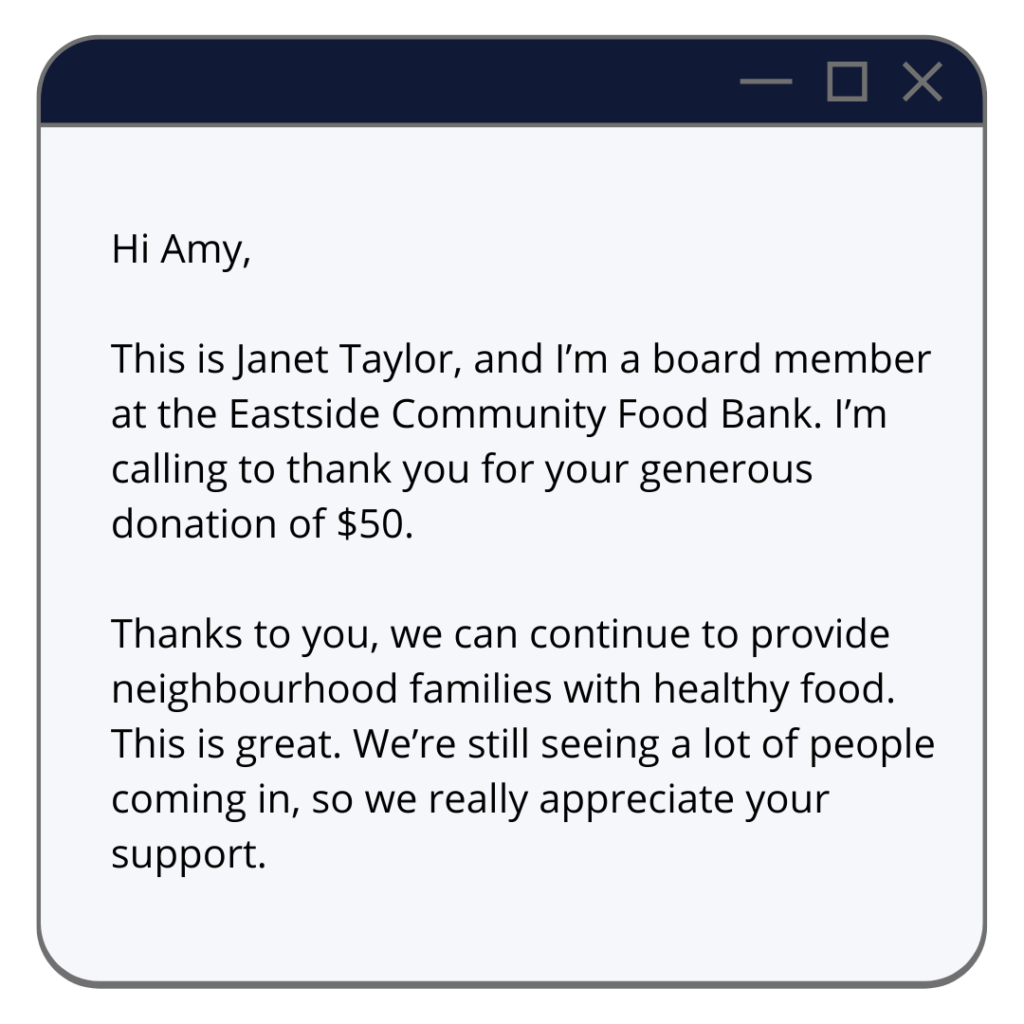Thanking donors is a critical part of nonprofit fundraising, maybe even more important than you think. In fact, because 71% of donors don’t give to the same organization twice, there’s a massive opportunity to retain more first-time donors with an effective plan for saying thank you for donations.
Additionally, thanking your donors throughout the year fosters a sense of loyalty and inclusion that in turn inspires bigger and more frequent gifts. In fact, studies show donor retention is much more important than donor acquisition because it’s easier to encourage past donors to give again than to find new first-time donors.
So, I’ve put together everything you need to know about creating a great thank you plan to engage your supporters, inspire generosity, and win your donors’ continued support.
FREE Thank You Letter Templates
Use these templates to craft general, campaign, and impact-focused thank you messages while expressing authentic gratitude and improving your donor stewardship..
1. Make a Good First Impression With Your Thank You Landing Page
Your website’s donation landing page is your first chance to say thank you. You should use your landing page as a way to engage your supporters and encourage them to make a donation by expressing authentic gratitude.
Open with “Thank you, Amy!” or “You’re amazing!” Try to include an engaging photo or video and a short, easy-to-understand description of how the donation will help your clients/community right now. Then, put all the tax-deductible information after your message or in the automatically generated thank you email.
In this position, I led the strategic direction and growth of all national signature events and specialized in emerging trends in fundraising, particularly studying data If you use a third-party giving site, you might be able to customize the post-donation landing page. If not, follow up with a personal thank you email. Research shows that when you do so within 48 hours, it is more well received by the donor.
2. Write a Personalized & Automated “Thank You for Your Donation” Email
Set up an automatic thank you email to go out after someone donates online. This email thank you is more of a reassurance to let your donors know you received their donation, like donation receipts. Of course, thanking them by mail or phone if you have time is another great way to connect with your supporters and show them how meaningful their donation is to your cause.
Also, for automatically generated thank you emails, try and edit the text to include more warm and personal content, showcasing gratitude to the donor.
Try to brainstorm some engaging subject lines like “Thank You” or “You did something great today.” Also, don’t use words that don’t evoke emotion, like “transaction” and “processed.” Technically, donations are transactions.
However, from a donor’s perspective, they’re giving their hard-earned money to a cause that means something special to them. So, using language that creates emotion will help you develop meaningful relationships.
3. Thank Your Donors Again by Mail or Phone
I’m a firm believer that every donor, no matter how much they’ve given or whether they’ve donated online, should get a donation thank you letter mailed to them or receive a phone call.
5 Email Templates to Boost Monthly Donations
Send targeted fundraising messages to first-time and sporadic donors to encourage them to give monthly and become lifelong supporters. e
For example, Penelope Burk, in her acclaimed book, Donor-Centred Fundraising, found that, on average, a thank you call from a board member to a newly acquired donor within 24 hours will increase their next gift by 39%.
Try to thank your donors within 48 hours or a week at the latest. I know it might be hard to do that right now, but it will be easier if you plan to carve out some time to thank your donors each day you get a donation. Remember, thanking your donors is a priority in order to develop meaningful relationships.
Instead of sending a generic thank you letter, mail a handwritten card or call your donors. Keep in mind that making thank you calls or writing the perfect thank you letter is something you can engage your board of directors to do.
You can engage your staff, board members, and volunteers to help make phone calls or write thank you notes to help you continue to showcase how important your donors are to your organization and to the cause you are supporting. Coming up with sample scripts will make this process smoother. You may want to conduct a short training (you can do this via Zoom).
Additionally, make sure to get your team together well before your next fundraising campaign, so you’re ready to go when the donations come in.
Here’s a sample donor thank you call script, which you can modify for a thank you note, letter, or email:

Send a handwritten thank you card
Also, you’ll stand out if you can send a handwritten thank you card. I get a few of these a year, and they tend to come from the same organizations, which shows you what they prioritize!
If you can’t send handwritten cards or call all your donors, send them a personal and heartfelt typed letter. If you’ve been using the same letter template for a while, it’s time to freshen it up. Don’t start your letter with “On behalf of ‘X’ organization; we thank you for your donation of. . . .”
Instead, open your letter with “You’re amazing” or “Because of you, the Carter Family can finally move into their own home.”
You can also create separate letters for new donors, renewing donors, and monthly donors to add an extra personal touch.
Try adding a personal handwritten note to the letter, preferably something that pertains to that particular donor. For example, if the donor has given before, mention that. Also, hand-sign the letters, if you can.
In addition, let your donors know how much you appreciate them and highlight what your organization is doing with their donations.
Last, write your personalized thank you letter at the same time you write your appeals. Make sure they’re ready to go as soon as the donations come in.
Free 2022 Fundraiser Salaries Guide
Learn salaries and job requirements for different fundraising positions including major gifts officer, grants manager, and fundraising director. Take the next step in your fundraising career!
4. Keep Thanking Your Donors All Year Round
As I mentioned before – thanking donors is a year-round activity.
You could use a communications calendar to track ways to thank your donors. But why not go one step further and create a specific thank you calendar?
Remember to try to say “thank you” for donations at least once a month.
- Send thank you messages consistently: Cards or email messages on Thanksgiving, Valentine’s Day, or even in June or September, when your donors may not be expecting it, can go a long way. Also, try to send at least one or two gratitude messages a year by letter mail.
- Invite your donors to connect: Via email and social media, keep donors updated with accomplishments and success stories, as well as how current events are impacting your work. Making all your communications donor-centered will help convey an attitude of gratitude. Also, be sure to keep thanking your donors in your newsletter and other updates. Finally, emphasize that you wouldn’t be able to do your work without your donors’ support.
- Create a thank you video: Record a thank you for donations message for your landing pages, emails, and social media platforms.
- Send a warm-up letter or email: About a month before your next campaign, send a message to get your supporters ready for upcoming events (no ask). This is a great way to show appreciation before you send your appeals.
- Host a virtual appreciation event: Depending on what’s going on with COVID, it may not be feasible to do an indoor gathering, such as an open house or giving tours. But, you could do something virtual to let your donors see your nonprofit up close and personal. Even when it is safe to gather in person, a virtual gathering or tour may be easier to pull off and more inclusive.
- Keep thinking of other ways to thank your donors: Set some time aside monthly to come up with some innovative ways of saying thank you for donations.
The tactics that work best differ for each organization and donor base. So, survey your donors to find out their communication preferences, as well as their interests. This will help with your engagement.
Creating a plan around saying thank you for donations will make it easier to keep showing appreciation to your donors all year round. You need your donors right now, so don’t hold back on that always-important gratitude.
A version of this post originally appeared on Ann Green’s Nonprofit Blog.

Ann Green
Nonprofit Communications Consultant
Ann is a Nonprofit Communications Consultant, specializing in donor engagement. She lives just outside Boston and enjoys reading, taking walks, and all things chocolate.
Connect with her on Twitter: @agreennonprofit







